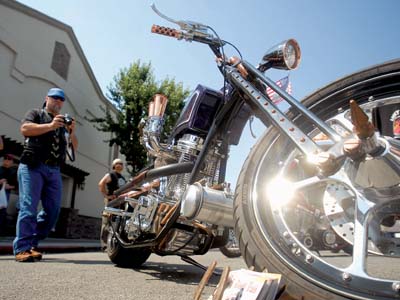
Some of the study’s other prominent findings were that Hollister
residents made up about one-third of the rally’s attendance and
that only 25 percent of visitors found lodging in the city,
according to the report.
HOLLISTER
A graduate student’s study of Hollister Motorcycle Rally economics estimates that consumers spent about $6.1 million as a result of the event, but also that most of it leaked to non-local businesses.
Some of the study’s other prominent findings were that Hollister residents made up about one-third of the rally’s attendance and that only 25 percent of visitors found lodging in the city, according to the report.
The study concludes that the $6.1 million spent by outsiders here during the rally is “likely to be directed towards non-local vendors which capture it from the local economy resulting in a leakage of economic benefit,” according to a report from Nicole Griffin, a graduate student at California State University, Monterey Bay.
The economic impact analysis for the rally – done at no cost to the city – surveyed visitors and asked local residents to provide “opinions and suggestions for future event management.” Other main points of focus for the survey were “spending, length of stay, party size and differentiation between visitor types,” according to the analysis.
There were 5,339 surveys handed in, of which 4,326 were useable. The remaining 1,013 surveys were disregarded due to inappropriate or inaccurate answers, reads the report, on which council members were set to hear a presentation Monday night.
City Manager Clint Quilter said these numbers are “not particularly surprising” and added how there are some holes. His example is a survey question on the amount of money spent – it originally had asked how much money they spent in Hollister but then was changed to how much they spent on their trip.
The study more conclusively, though, did find that nearly one-third of the estimated 92,500 visitors to the rally were Hollister residents. Of the remaining two-thirds of non-residents, only 25.5 percent of those stayed in the city, it estimated, while 21.2 percent stayed in San Jose, 17.5 percent in Gilroy and 17 percent in Salinas.
The $6.1 million figure was defined as direct spending – which is “dollars spent within the city related to the event that would otherwise be spent outside the economy.” Even though $6.1 million is being spent, however, “only part of the money remains locally when it changes hands,” the report reads.
The analysis also has suggestions for keeping more money in the local economy. One solution is to give booth spaces or significantly reduce their rates to local businesses so money doesn’t leave the area. Another is to eliminate outside vendors.
Quilter said the findings aren’t really any different from what officials thought before and they should be “taken as an order of magnitude and take it for what it is.” Even with these numbers, he said it is still up to the council to decide whether to spend between $100,000 and $250,000 on the rally.









